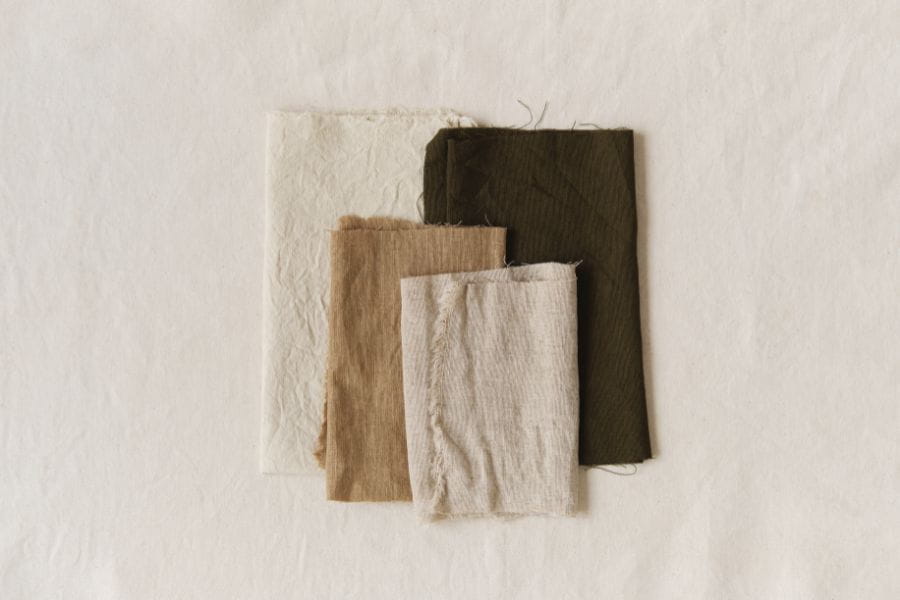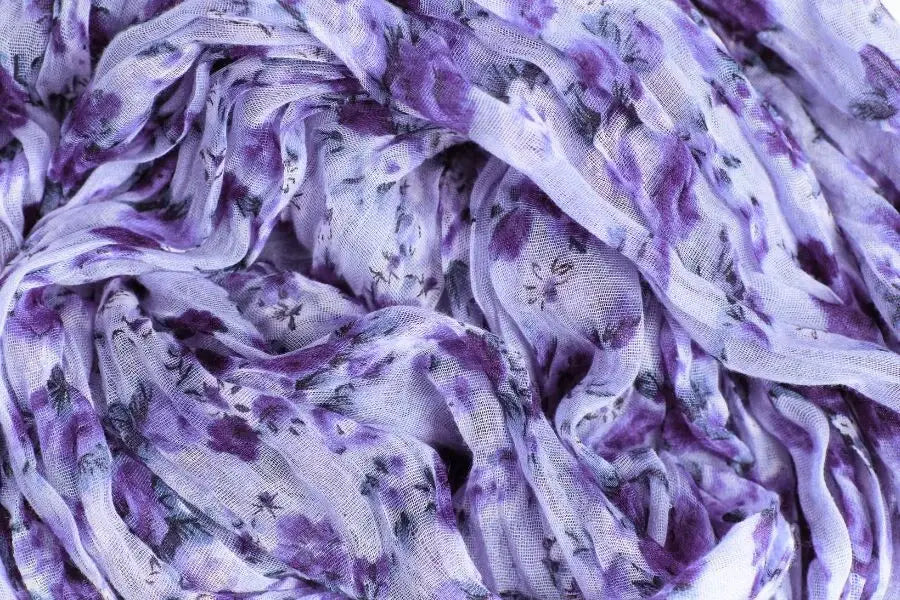
Best Fabric for Hot Weather: Breathable Fabric for Summer
Key Takeaways
- Not all “breathable” fabrics are created equal. What makes some fabrics more effective at keeping you cool than others, despite similar claims?
- Modern synthetic fabrics are challenging traditional natural fibers for summer wear. Read more to learn how these choices compare when deciding your best fabric for hot weather.
- Can you stay cool and stylish simultaneously? Explore the balance between fashion-forward summer wear and optimal hot weather comfort.
What Is The Best Material For Hot Weather?
1. Cotton
Cotton has been a hot weather pillar for centuries, and with good cause! Its unique structure makes it a champion at dealing with heat and sweat, both of which we’ve had enough of during those scorching summer days.

Cotton fabric
Its pros can include:
- Naturally breathable: Cotton has a natural fibre structure, letting air flow through easily. This helps keep you cool and prevents that icky, sticky feeling we all hate in hot weather.
- Moisture-absorbing: Cotton is also great at soaking up sweat (gross, but necessary). It can absorb up to 24-27 times its weight in water, which helps in drawing sweat away from the skin.
- Widely available: Cotton clothes are everywhere, from budget-friendly shops to high-end boutiques.
Of course, cotton isn’t perfect (but hey, who is?) for these certain qualities:
- Tend to wrinkle: Cotton wrinkles easily so you might look crumpled by the end of a long, hot day.
- Moisture magnet: While it is effective at absorbing sweat, it can sometimes retain moisture for too long, leaving you feeling damp if you are working up a sweat.
2. Linen
Linen often pops up when searching for the best material for hot weather. It’s made of the flax plant and is known for its incredible ability to handle heat and effortlessly chic aesthetics.

Linen fabric
Here’s why linen is such a standout choice for summer fabrics:
- Breathable: Linen allows air to move freely, keeping you fresh even as the temperature rises. It is also highly absorbent, absorbing up to 20% of its weight in moisture before becoming damp.
- Quick dry champion: Caught in a surprise summer shower? No sweat! Linen dries in a flash so you won’t feel damp for long.
- Lightweight: Featherlight and airy, this fabric offers unparalleled comfort from dawn to dusk.
Like all good things, linen has its downsides:
- Prone to wrinkles: Linen has a relaxed, lived-in look due to its ease of wrinkles. This can be a vibe, but some may disagree.
- Rough texture: Linen can feel rough, especially when you’ve just got it from the store. However, it softens up beautifully over time. Remember to handle it carefully to preserve fabric quality!
3. Rayon
Meet rayon, the fabric world’s shape-shifter. Straddling the line between natural and synthetic, this clever fabric starts life as humble plant pulp and gets zapped with science to become a super-comfy textile. Old-school summer fabrics are getting quite a competitor!

Rayon fabric
Rayon’s got some pretty nifty features that make it a summer superstar:
- Soft texture: Rayon feels amazing against your skin thanks to its smooth fibres and low surface friction.
- Drapes well: Its molecular structure helps the fabric flow elegantly, giving you an effortlessly stylish look.
- Chill factor: Rayon's high moisture absorption capacity and breathability make it feel like a refreshing dip in a cool stream, even on the hottest days.
However, there are a few things to keep in mind:
- Low durability: Rayon isn’t the toughest kid on the block, so it needs some extra TLC. The chemical processing involved in its production can lead to a loss of fibre strength, making it more prone to wear and tear.
- Shrink when wet: If your rayon clothes suddenly don’t fit anymore, it’s not you—it’s the fabric. So, be extra careful: hand wash them in cold water with a mild detergent. Don’t wring or twist!
4. Bamboo
Bamboo fabric is made from the pulp of bamboo grass, a plant that grows quickly and requires the lowest level of maintenance. Environmentally friendly alert! Plus, bamboo’s natural properties make it perfect for keeping cool during heatwaves.

Bamboo fabric
Let’s break down why bamboo is becoming a summer favourite:
- Breathable: Bamboo fibres have tiny gaps in their structure, allowing air to flow freely. We all know your sweat glands love this!
- Moisture-wicking: The fibres are excellent in removing sweat from your skin and spreading it out, allowing it to go away fast. No more sticky, icky feeling!
- Soft texture: Its ultra-smooth fibers caress your skin like you hardly wear anything at all. If you have sensitive skin or simply love comfy clothes, you should try this.
On the other hand, let’s go through a couple of things to keep in mind:
- Higher price: The process of turning bamboo into fabric is quite complex, including specialised equipment, chemical processes, energy requirements, etc. All of those can make it more expensive than some other materials.
- Lower durability: Bamboo fabric isn’t as durable as some other types. It could require extra delicate attention to keep it looking its best.
5. Chambray
Now, you might be thinking, “Isn’t chambray just lightweight denim?” Well, not quite!
Both use colored warp and white weft threads, but their weave patterns set them apart. Denim is woven in a way that makes little diagonal lines. This gives it a tough, rugged look and feel. On the other hand, Chambray is woven in a simple criss-cross pattern for a smoother, light pattern.

Chambray vs. denim
Some reasons why chambray can be the next best fabric for hot weather are:
- Featherweight: Chambray is lighter than denim, making it ideal for unexpected heatwaves.
- Breathable: One of the most breathable fabrics, the plain weave structure allows air to circulate easily to keep you cool as a cucumber.
- High durability: Despite its lightness, chambray is surprisingly durable. It can handle your summer adventures without breaking a sweat.
But…
- May fade over time: Chambray may fade with time and after repeated washing. Some people enjoy the lived-in look, while others may find it unappealing.
- Less stretch: Compared to some modern denim, chambray typically lacks stretch. Not the best choice if you’re planning on impromptu yoga in the park.
6. Modal
Modal is a fever dream for summer clothing—flowy dresses, soft T-shirts, comfy pyjamas, anything you can think of.
A trivia you might need later in game nights: Modal isn’t some new-fangled invention. It’s been around since the 1950s when some clever folks in Japan decided to create a kind fabric for your skin and the planet.

Modal fabric
This hottie is becoming a summer favourite for these reasons:
- Incredibly soft: Modal is ridiculously soft, softer than a kitten’s paw even. This is a result of its smooth fibre structure, created by its regenerated cellulose composition.
- Cool and breezy: Modal’s unique weave creates a micro-ventilation system, regulating your body heat like a pro. Thus, making it one of the best options for staying cool and comfy in the heat.
- Moisture-wicking: For its hydrophilic nature, modal is an excellent choice for navigating stuffy public transport or crowded city streets. Sweating won’t even cross your mind.
On the contrary, there are some cons for you to consider:
- Pilling potential: Modal can develop those little fabric bobbles we all know and don’t love over time. But don't worry, it's less susceptible to pilling than other fabrics.
- Heat sensitivity: While great for keeping you cool, modal doesn’t love extreme heat. So maybe skip the hot iron and opt for a cool setting instead.
See more: Summer Outfit Ideas
Frequently Asked Questions
What fabrics should I avoid wearing in hot weather?
Steer clear of heat-trapping fabrics such as polyester, nylon, and leather. These materials don’t breathe well and will make you feel hot and sweaty.
Can synthetic fabrics be good for hot weather?
Yes, some, like moisture-wicking polyester blends or specially designed athletic wear, are designed to pull sweat away from your skin and dry quickly, helping you stay cool.
Are there specific fabrics that prevent sweat stains?
No fabric can completely prevent sweat stains, the best options are moisture-wicking fabrics like merino wool, bamboo, and specific synthetic blends to reduce visible sweat marks. Dark colours and patterned fabrics also better hide sweat stains.
Leave a comment